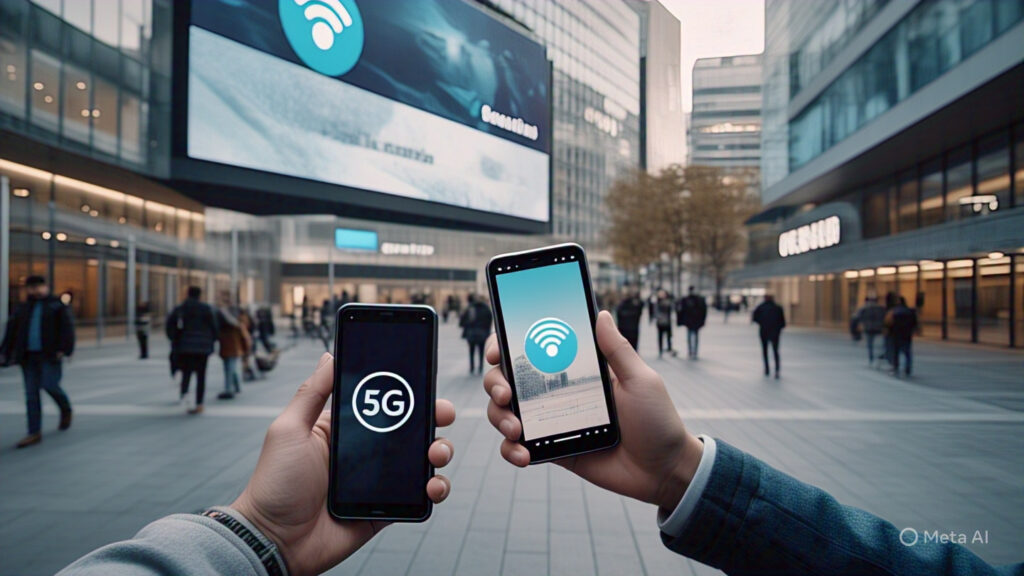As we march deeper into the digital age, connectivity is no longer a luxury—it’s the backbone of our daily lives. Whether you’re streaming a 4K movie, joining a Zoom call from a remote island, or controlling your smart home, seamless internet access is essential. Two key players dominate this wireless ecosystem: 5G and Wi-Fi. Both technologies promise lightning-fast speeds, low latency, and support for massive numbers of connected devices. But which one is better? Are they competitors or collaborators?
This in-depth exploration dives into the evolution, technical differences, use cases, and future of 5G and Wi-Fi, aiming to settle the debate—or at least help you understand when to use which.
The Evolution of Wireless Connectivity
Before we dive into the head-to-head comparison, it’s important to understand where both technologies come from and how they’ve evolved.
Wi-Fi: The Local Hero
Wi-Fi has been the go-to solution for home and office wireless internet since the late 1990s. Developed from IEEE 802.11 standards, Wi-Fi provides wireless local area network (WLAN) access within a limited range—usually a building or campus.
-
Wi-Fi 4 (802.11n): Introduced MIMO (multiple-input, multiple-output) antennas.
-
Wi-Fi 5 (802.11ac): Improved speeds and signal reliability.
-
Wi-Fi 6/6E (802.11ax): Introduced better performance in congested environments and access to the 6 GHz band.
-
Wi-Fi 7 (802.11be): Offers multi-gigabit speeds, ultra-low latency, and simultaneous multi-band operation.
5G: The Global Contender
5G, the fifth generation of mobile networks, was launched to support the demands of a hyperconnected society. Unlike Wi-Fi, which relies on a local router, 5G operates over licensed spectrum bands and is managed by telecom operators.
-
Sub-6 GHz 5G: Offers broad coverage and decent speeds.
-
mmWave 5G: Delivers ultra-fast speeds but with a shorter range and lower penetration through walls.
-
5G Standalone (SA): A pure 5G architecture with ultra-low latency and network slicing capabilities.
Key Technical Differences
Let’s compare the two technologies across some key technical parameters:
| Feature | 5G | Wi-Fi |
|---|---|---|
| Spectrum | Licensed (Sub-6 GHz, mmWave) | Unlicensed (2.4 GHz, 5 GHz, 6 GHz) |
| Deployment | Managed by telecoms, wide-area | User-managed, local area |
| Range | Wide (especially Sub-6) | Short (limited to building/campus) |
| Speed | Up to 10 Gbps (mmWave) | Up to 40 Gbps (Wi-Fi 7) |
| Latency | As low as 1 ms | Around 2-5 ms (Wi-Fi 6/7) |
| Device Support | Massive IoT, mobile devices | PCs, phones, smart home devices |
| Security | SIM-based, operator control | Password-based, WPA3 encryption |
| Mobility | Excellent for moving devices | Limited, handoff between routers needed |
Use Cases: Where Each Technology Excels
Wi-Fi’s Strengths
-
Homes and Offices
Wi-Fi remains the most cost-effective and reliable option for indoor environments. Most routers can now support dozens of devices simultaneously with minimal interference. -
Cost Control
Wi-Fi is typically cheaper as users don’t pay per GB of data. There’s no need for a cellular plan, and you control your own network. -
Bandwidth-Heavy Tasks
For tasks like streaming 4K/8K content, online gaming, or file sharing over LAN, Wi-Fi 6 and 7 offer exceptional performance, especially in environments with multiple users.
5G’s Strengths
-
Mobility and Coverage
5G shines in outdoor environments or where mobility is critical—think smart cities, autonomous vehicles, and connected logistics. -
Ultra-Reliable Low Latency
Industrial automation, remote surgery, and augmented reality demand extremely low latency and high reliability, which 5G Standalone networks can deliver. -
Massive IoT
With its ability to connect millions of devices per square kilometer, 5G is ideal for large-scale sensor networks, such as smart agriculture or urban infrastructure.
Speed and Latency: Who’s Faster?
While both technologies promise blazing-fast performance, the real-world experience varies depending on the environment.
-
Wi-Fi 7 can theoretically reach up to 40 Gbps, although average home networks will be far lower due to router limits and interference.
-
mmWave 5G offers up to 10 Gbps, but it requires line-of-sight and is sensitive to obstacles like walls or rain.
-
In controlled conditions, 5G latency can drop below 1 millisecond, but Wi-Fi 6/7 usually offers 2–5 ms, which is more than adequate for most applications.
Verdict:
In terms of raw speed, Wi-Fi 7 may take the crown indoors. But 5G, especially Standalone and mmWave, dominates in scenarios demanding real-time responsiveness and mobility.
Security Showdown
Security is a vital concern in today’s connected world. How do 5G and Wi-Fi compare?
Wi-Fi Security
-
WPA3 Encryption: The latest Wi-Fi security protocol improves protection against brute-force attacks.
-
User Control: You manage your router and decide who joins your network.
-
Vulnerability: Open or poorly configured networks are often targeted by hackers.
5G Security
-
SIM-Based Authentication: More robust and centralized than passwords.
-
Network Slicing: Allows dedicated, isolated virtual networks for specific services.
-
Carrier-Grade Security: Regular updates, encryption, and authentication managed by mobile operators.
Verdict:
While modern Wi-Fi security is strong, 5G offers enterprise-grade protections by default, especially in sensitive or large-scale deployments.
Cost Comparison
Another major consideration is cost—both for the end-user and for organizations.
-
Wi-Fi: One-time router cost, no monthly data fees. Better for fixed locations and predictable use.
-
5G: Monthly plan fees, especially for high-speed or unlimited data. Infrastructure is costlier to build and maintain, but you get wide coverage.
Enterprise Deployments:
Businesses deploying private 5G networks for campuses or factories face higher initial investment but gain more control over large, mobile operations.
Collaboration, Not Competition
It’s tempting to pit 5G and Wi-Fi as rivals, but the reality is more nuanced. Many future environments will use both technologies in tandem, switching seamlessly depending on location, application, and user behavior.
-
Smartphones: Automatically switch between 5G and Wi-Fi for optimal performance.
-
Offices: Wi-Fi for internal data, 5G backup for resilience or guest connectivity.
-
Factories: Private 5G for machine-to-machine communications, Wi-Fi for employee devices.
-
Enterprise Adoption: Private 5G vs Wi-Fi Networks
As digital transformation accelerates, enterprises are moving beyond traditional IT infrastructure and adopting advanced wireless technologies to enhance productivity, security, and innovation.
The Rise of Private 5G
Private 5G networks—custom cellular networks deployed on-premises by enterprises—are gaining momentum in industries such as manufacturing, logistics, and healthcare. These networks offer:
-
High reliability and low latency for mission-critical applications.
-
Network slicing to create dedicated virtual channels for different departments or use cases.
-
Enhanced mobility across large facilities, such as airports, factories, or campuses.
Example:
BMW has deployed private 5G in its factories to enable autonomous transport systems and real-time quality control using AI-driven video analytics.Wi-Fi in Enterprise Environments
Despite the rise of 5G, Wi-Fi remains dominant in many enterprise environments due to:
-
Lower cost of deployment and maintenance
-
Compatibility with a wide range of consumer and business devices
-
Easy management with modern mesh networking and cloud controllers
Example:
Modern offices use Wi-Fi 6 or Wi-Fi 6E to support dense environments, offering enough bandwidth for video calls, file sharing, and IoT integration.Hybrid Approach: The Best of Both Worlds
Some enterprises are choosing hybrid architectures, where Wi-Fi handles general productivity needs, and 5G covers specialized use cases that demand greater reliability or outdoor coverage.
Smart Homes and Consumer Devices
Wi-Fi: The Backbone of the Smart Home
Smart home devices—thermostats, cameras, lights, smart TVs—still overwhelmingly depend on Wi-Fi for connectivity. Its advantages include:
-
Easy setup with consumer routers
-
Broad compatibility with IoT ecosystems (Alexa, Google Home, etc.)
-
No ongoing data costs
However, as smart homes become more complex, congestion on Wi-Fi networks is a growing concern.
5G: The Next Frontier for Consumers?
5G is beginning to enter the consumer space through:
-
5G home internet: Fixed Wireless Access (FWA) is competing with fiber and cable in many regions.
-
Mobile AR/VR: Applications like gaming or virtual collaboration may soon require 5G’s ultra-low latency.
-
Wearables and automotive: Connected cars and health-monitoring wearables can stay connected without Wi-Fi.
Emerging Applications and Trends
Wi-Fi 7 and Beyond
Wi-Fi 7 is pushing the boundaries of what’s possible in local wireless communication. Key innovations include:
-
Multi-Link Operation (MLO): Allows simultaneous use of multiple bands for faster and more stable connections.
-
4K QAM (Quadrature Amplitude Modulation): Enables higher data rates.
-
Reduced latency for AR/VR and real-time apps
Wi-Fi 8 (tentatively scheduled for the 2030s) may bring in AI-enhanced optimization and greater coexistence with 5G.
5G Advanced and 6G
The future of 5G lies in 5G Advanced, which adds:
-
Better energy efficiency
-
More precise location tracking
-
Integration with AI and ML for dynamic network management
6G, expected around 2030, could offer:
-
Terahertz spectrum for even higher speeds
-
Holographic communication
-
Real-time digital twins
-
Full integration with space-based networks (satellite 6G)
Global Rollout and Accessibility
Wi-Fi Availability
Wi-Fi is nearly ubiquitous in developed regions but relies on local infrastructure like routers and ISPs. In developing areas, poor broadband access limits Wi-Fi’s reach.
5G Coverage
5G is expanding rapidly, but coverage quality varies:
-
Urban Areas: Dense mmWave deployment offers blazing speeds.
-
Suburban/Rural: Sub-6 GHz provides wider but slower coverage.
-
Emerging Markets: 4G remains dominant; 5G rollout is slower due to infrastructure costs.
Despite hype, many regions still experience patchy 5G, while Wi-Fi remains more predictable where broadband is available.
Environmental Impact
With sustainability in mind, both technologies have pros and cons.
Wi-Fi
-
Lower power consumption per device
-
Easier to recycle and manage hardware
-
Localized impact
5G
-
Higher initial energy demands (especially mmWave)
-
Large-scale tower deployments
-
New 5G modems in devices add e-waste concerns
However, 5G Advanced aims to reduce power usage significantly, using AI to switch resources dynamically.
Final Verdict: Which Should You Use?
There’s no universal winner—the best choice depends on the context. Here’s a quick breakdown:
Scenario Recommended Tech Home and Office Wi-Fi 6/7 On-the-go connectivity 5G Industrial automation Private 5G Smart homes Wi-Fi Large outdoor venues 5G Rural internet access 5G FWA Heavy file sharing / LAN gaming Wi-Fi 6/7 Mobile AR/VR 5G mmWave IoT in agriculture / cities 5G Massive IoT Complementary Forces
Rather than competing, 5G and Wi-Fi are increasingly working in harmony. Devices like smartphones and laptops now include dual connectivity options, allowing dynamic switching between networks based on speed, cost, and location.
Conclusion
The wireless future is not about choosing between 5G and Wi-Fi—it’s about using the right tool for the right task. As both technologies continue to evolve, they’ll unlock new experiences, transform industries, and connect the world in ways we’re only beginning to imagine.
So whether you’re gaming in your bedroom or operating a smart farm, one thing is clear: connectivity is king—and both 5G and Wi-Fi are fighting to wear the crown.
-



